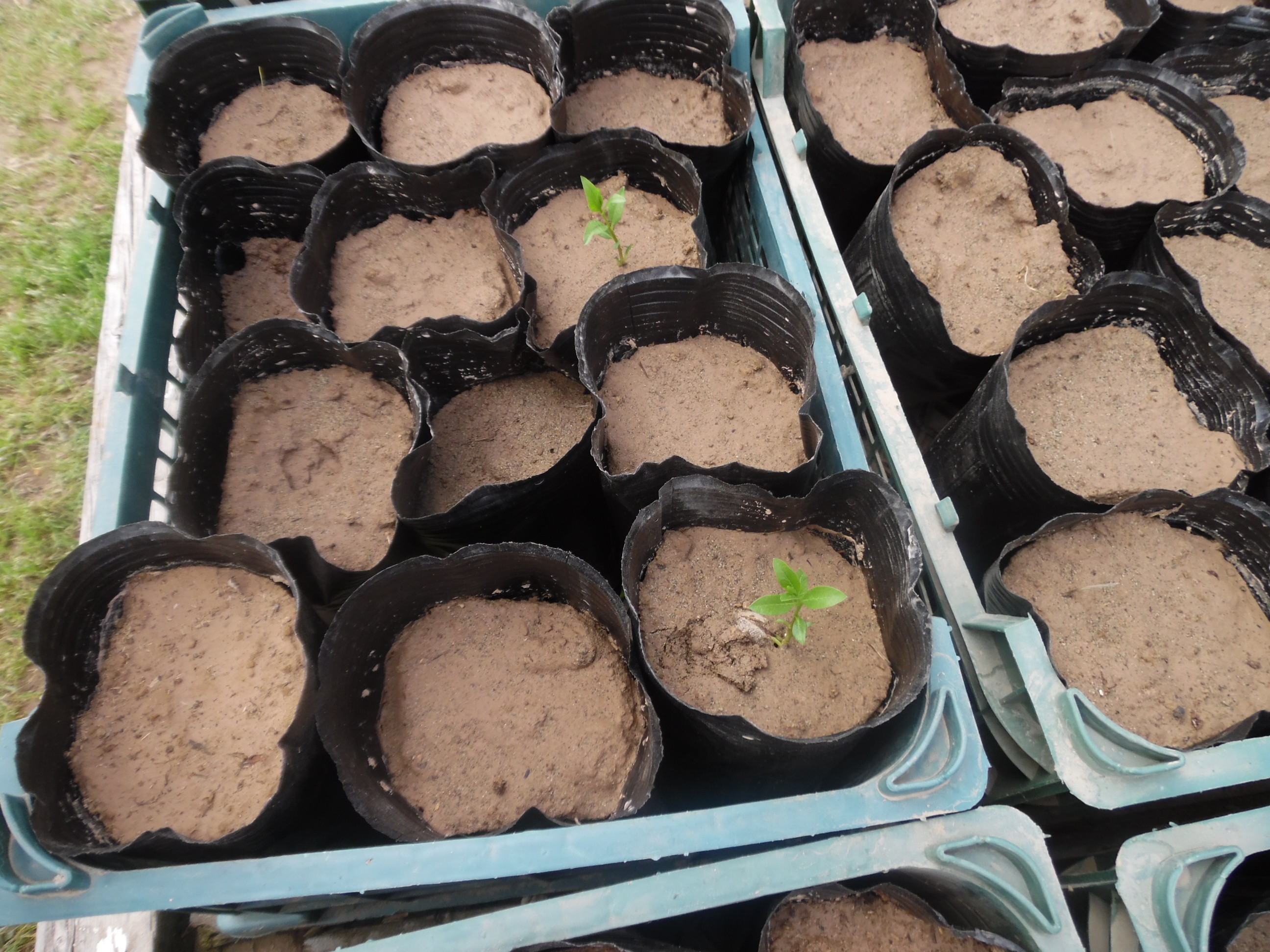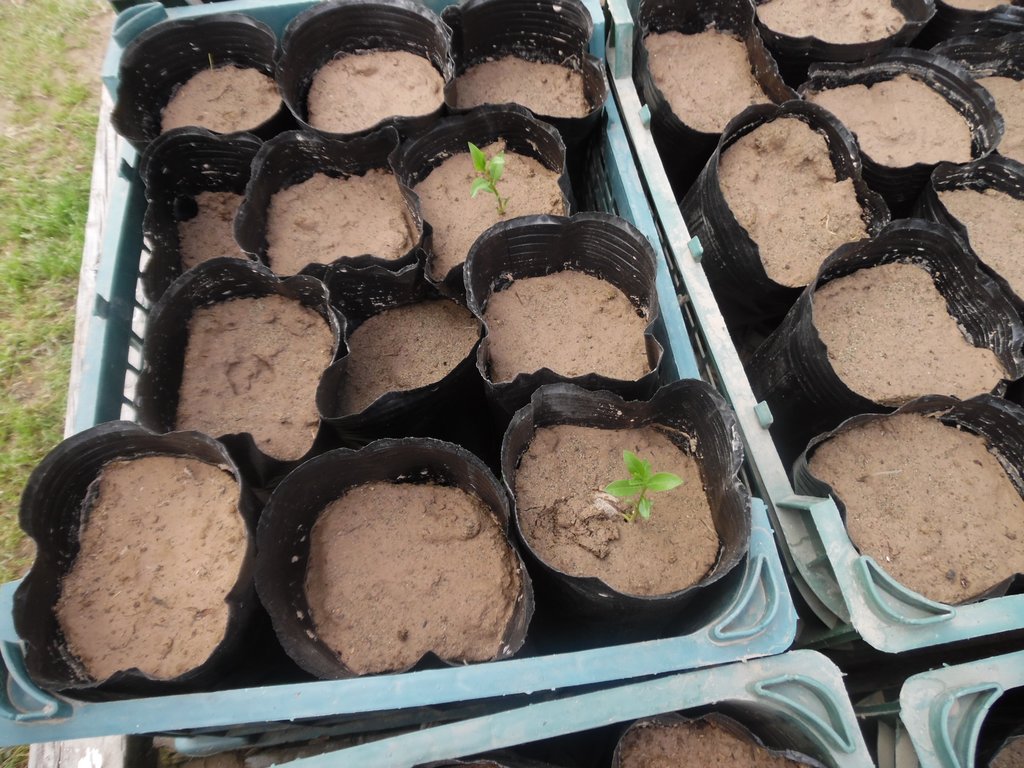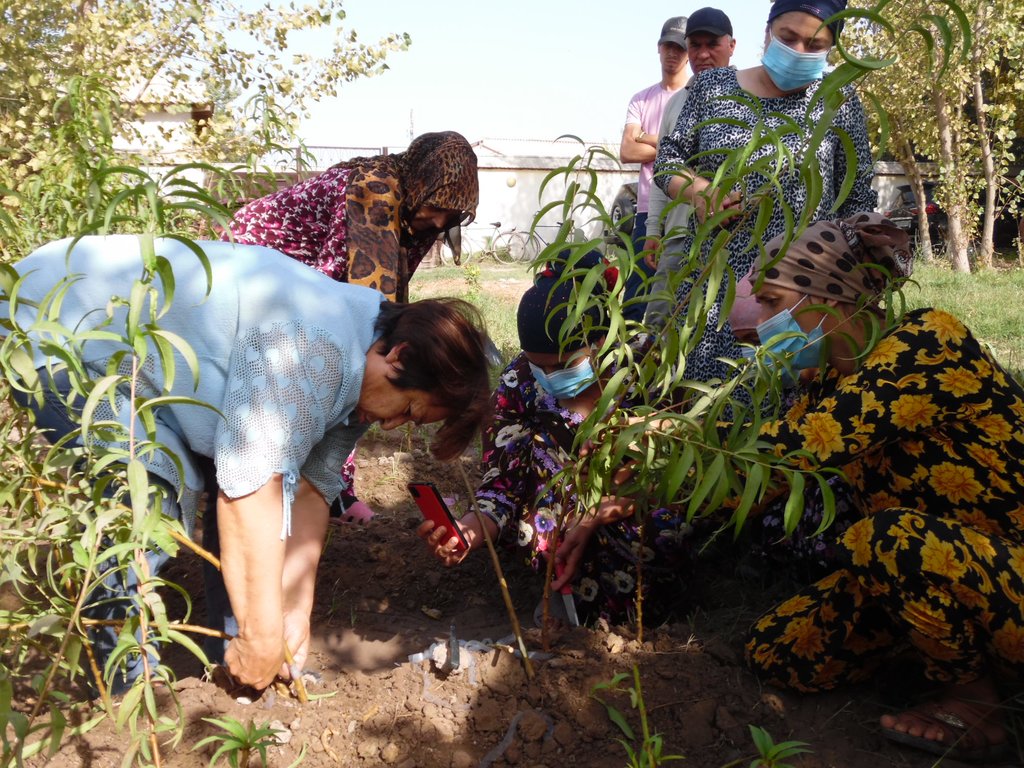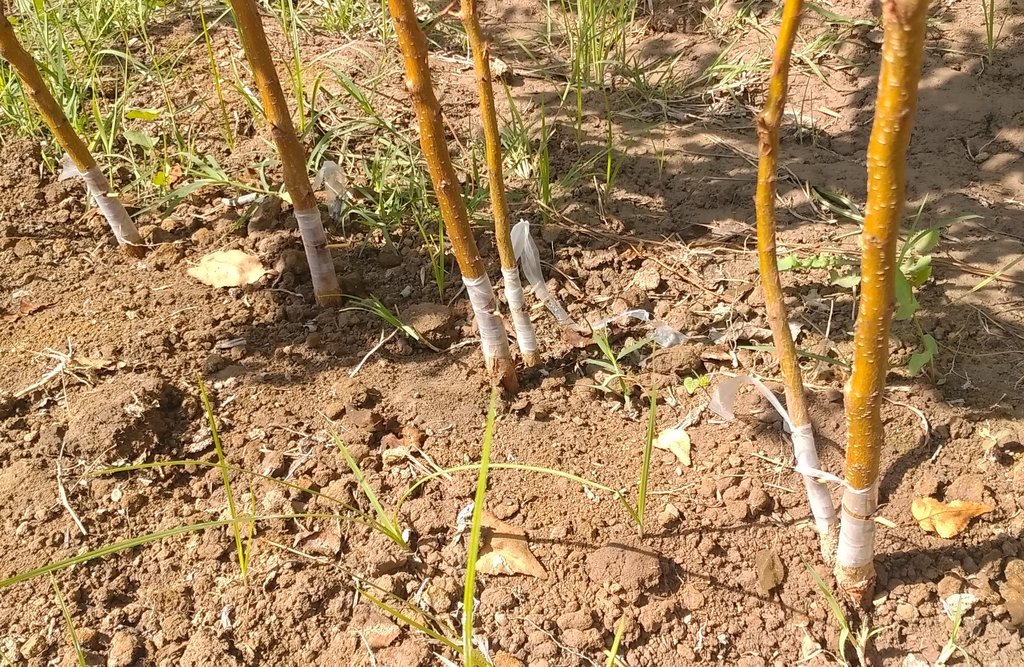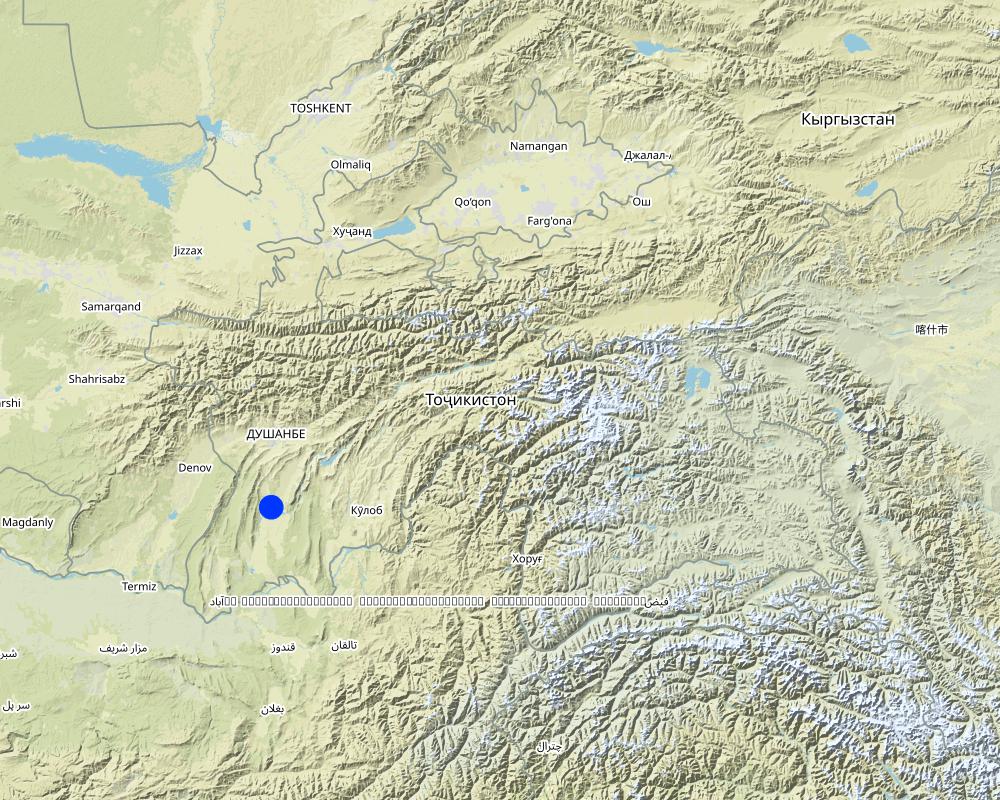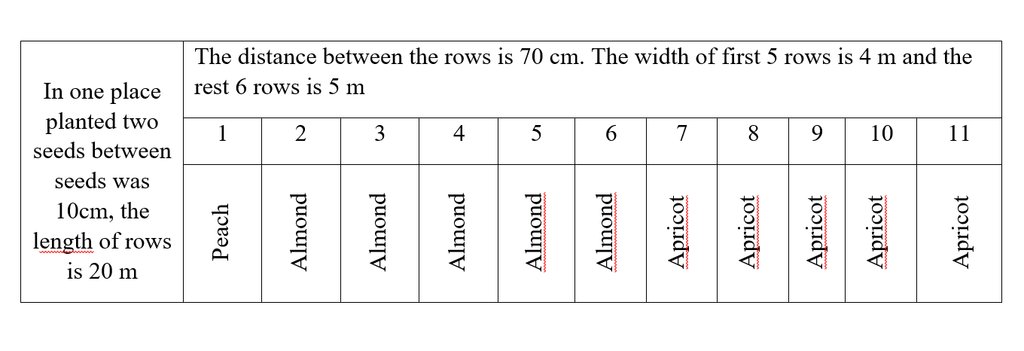Production of drought-resistant fruit seedlings by women's groups. [塔吉克斯坦]
- 创建:
- 更新:
- 编制者: Daler Domullodzhanov
- 编辑者: –
- 审查者: William Critchley, Rima Mekdaschi Studer
Истеҳсоли ниҳолҳои дарахтони ба хушкӣ тобовар ва мевадиҳанда аз ҷониби гуруҳи занон.
technologies_6165 - 塔吉克斯坦
查看章节
全部展开 全部收起1. 一般信息
1.2 参与该技术评估和文件编制的资源人员和机构的联系方式
有助于对技术进行记录/评估的项目名称(如相关)
Integrated natural resources management in drought-prone and salt-affected agricultural production landscapes in Central Asia and Turkey ((CACILM-2))有助于对技术进行记录/评估的机构名称(如相关)
FAO Tajikistan (FAO Tajikistan) - 塔吉克斯坦1.3 关于使用通过WOCAT记录的数据的条件
编制者和关键资源人员接受有关使用通过WOCAT记录数据的条件。:
是
1.4 所述技术的可持续性声明
这里所描述的技术在土地退化方面是否存在问题,导致无法被认为是一种可持续的土地管理技术?:
否
2. SLM技术的说明
2.1 技术简介
技术定义:
Drought-resistant fruit seedlings are being produced by vulnerable, women-led households in backyard nurseries. These will be planted out in agroforestry plots within the dry agrolandscapes of Southern Tajikistan.
2.2 技术的详细说明
说明:
The availability of high-quality and drought-resistant fruit tree saplings is a major constraint to establishing agroforestry plots in the extremely dry agrolandscapes of Southern Tajikistan. While productive, these trees - Almonds, Apricots and Peaches - planted in agroforestry systems can help fight desertification through stabilizing slopes and reducing soil erosion. The FAO/GEF financed CACILM2 project promotes the establishment of backyard nurseries through farmer groups, formed in the targeted districts. The FAO project has coached women's group members to establish nurseries in their kitchen gardens. Season-long training workshops were held for groups of farmers (dominated by women) starting from the selection of better adapted, more productive, drought-resistant varieties. Training was also given on planting/transplanting, grafting, applying fertilizers and preparation of seedlings for transplantation. Farmer groups members have established nurseries in their kitchen gardens on plots of 200-300 square metres: each square metre can produce 20-30 grafted seedlings.
2.3 技术照片
2.5 已应用该技术的、本评估所涵盖的国家/地区/地点
国家:
塔吉克斯坦
区域/州/省:
Khatlon region, A. Jomi district
有关地点的进一步说明:
Mushkurut village
具体说明该技术的分布:
- 均匀地分布在一个区域
如果不知道精确的区域,请注明大致覆盖的区域:
- < 0.1 平方千米(10 公顷)
技术现场是否位于永久保护区?:
否
Map
×2.6 实施日期
如果不知道确切的年份,请说明大概的日期:
- 不到10年前(最近)
2.7 技术介绍
详细说明该技术是如何引入的:
- 通过项目/外部干预
3. SLM技术的分类
3.1 该技术的主要目的
- 改良生产
- 减少、预防、恢复土地退化
- 降低灾害风险
- 适应气候变化/极端天气及其影响
- 减缓气候变化及其影响
3.2 应用该技术的当前土地利用类型
同一土地单元内混合使用的土地::
否

其它
具体说明:
Kitchen garden plots
3.3 由于技术的实施,土地使用是否发生了变化?
由于技术的实施,土地使用是否发生了变化?:
- 是(请在技术实施前填写以下有关土地利用的问题)
同一土地单元内混合使用的土地::
否

其它
具体说明:
kitchen garden plots
3.4 供水
该技术所应用土地的供水:
- 充分灌溉
3.5 该技术所属的SLM组
- 农业林学
- 防风林/防护林带
- 家庭花园
3.6 包含该技术的可持续土地管理措施

植物措施
- V1:乔木和灌木覆盖层

管理措施
- M1:改变土地使用类型
3.7 该技术强调的主要土地退化类型

土壤水蚀
- Wt:表土流失/地表侵蚀
- Wg:冲沟侵蚀/沟蚀

土壤风蚀
- Et:表土流失
- Ed:风蚀风积
3.8 防止、减少或恢复土地退化
具体数量名该技术与土地退化有关的目标:
- 防止土地退化
- 减少土地退化
4. 技术规范、实施活动、投入和成本
4.1 该技术的技术图纸
技术规范(与技术图纸相关):
The total area under 11 rows (4 m x 20m = 80, 5m x 40m = 200) occupied for the seedling production is 280 m2.
作者:
Marufqul Mahkamov
日期:
02/03/2021
4.2 有关投入和成本计算的一般信息
具体说明成本和投入是如何计算的:
- 每个技术区域
注明尺寸和面积单位:
280 sq m
具体说明成本计算所用货币:
- 美元
4.3 技术建立活动
| 活动 | 时间(季度) | |
|---|---|---|
| 1. | Plowing of the land by hand | April |
| 2. | Preparing the rows for the planting | April |
| 3. | Planting by hand | April |
| 4. | Inter-row cultivation | May |
| 5. | First time application of fertilizers, by hand | May - June |
| 6. | Mannual weeding | June - July |
| 7. | Second time application of fertilizers, by hand | July |
| 8. | Monitoring and providing consultations | March-September |
| 9. | Grafting | June-July |
| 10. | Recording activities in a field book | March-September |
4.4 技术建立所需要的费用和投入
| 对投入进行具体说明 | 单位 | 数量 | 单位成本 | 每项投入的总成本 | 土地使用者承担的成本% | |
|---|---|---|---|---|---|---|
| 劳动力 | Plowing of the land by hand, preparing the rows for the planting and planting seeds by hand | man days | 2.5 | 50.0 | 125.0 | 100.0 |
| 劳动力 | Inter row cultivation and manual weeding | man days | 1.8 | 30.0 | 54.0 | 100.0 |
| 劳动力 | Two times application of fertilizers, by hand | man days | 1.0 | 10.0 | 10.0 | 100.0 |
| 劳动力 | Grafting | man days | 1.4 | 50.0 | 70.0 | |
| 设备 | Grafting tools | set | 1.0 | 20.0 | 20.0 | |
| 植物材料 | Seed of almond, apricot and peach | kg | 11.3 | 10.0 | 113.0 | |
| 肥料和杀菌剂 | Mineral fertilizers | kg | 45.3 | 0.7 | 31.71 | |
| 其它 | Monitoring and providing consultations | man days | 0.5 | 50.0 | 25.0 | |
| 其它 | Recording the activities realization in the field book | man days | 1.0 | 20.0 | 20.0 | 100.0 |
| 其它 | Arranging of training on backyard nursery | man days | 1.0 | 50.0 | 50.0 | |
| 技术建立所需总成本 | 518.71 | |||||
| 技术建立总成本,美元 | 518.71 | |||||
如果土地使用者负担的费用少于100%,请注明由谁负担其余费用:
FAO CACILM-2 project
4.5 维护/经常性活动
| 活动 | 时间/频率 | |
|---|---|---|
| 1. | Inter row cultivation | May |
| 2. | First time application of fertilizers, by hand | May - June |
| 3. | Mannual weeding | June - July |
| 4. | Second time application of fertilizers, by hand | July |
| 5. | Monitoring and providing consultations | March - September |
| 6. | Recording the activities realization in the field book | March - September |
4.6 维护/经常性活动所需要的费用和投入(每年)
| 对投入进行具体说明 | 单位 | 数量 | 单位成本 | 每项投入的总成本 | 土地使用者承担的成本% | |
|---|---|---|---|---|---|---|
| 劳动力 | Inter row cultivation and mannual weeding | man days | 1.8 | 30.0 | 54.0 | 100.0 |
| 劳动力 | Two times application of fertilizers, by hand | man days | 1.0 | 10.0 | 10.0 | 100.0 |
| 劳动力 | Monitoring and providing consultations | man days | 0.5 | 50.0 | 25.0 | 100.0 |
| 劳动力 | Recording the activities realization in the field book | man days | 1.0 | 20.0 | 20.0 | 100.0 |
| 肥料和杀菌剂 | Mineral fertilizers | kg | 45.3 | 0.7 | 31.71 | 100.0 |
| 技术维护所需总成本 | 140.71 | |||||
| 技术维护总成本,美元 | 140.71 | |||||
4.7 影响成本的最重要因素
描述影响成本的最决定性因素:
High inflation rate
5. 自然和人文环境
5.1 气候
年降雨量
- < 250毫米
- 251-500毫米
- 501-750毫米
- 751-1,000毫米
- 1,001-1,500毫米
- 1,501-2,000毫米
- 2,001-3,000毫米
- 3,001-4,000毫米
- > 4,000毫米
指定年平均降雨量(若已知),单位为mm:
455.00
农业气候带
- 干旱
5.2 地形
平均坡度:
- 水平(0-2%)
- 缓降(3-5%)
- 平缓(6-10%)
- 滚坡(11-15%)
- 崎岖(16-30%)
- 陡峭(31-60%)
- 非常陡峭(>60%)
地形:
- 高原/平原
- 山脊
- 山坡
- 山地斜坡
- 麓坡
- 谷底
垂直分布带:
- 0-100 m a.s.l.
- 101-500 m a.s.l.
- 501-1,000 m a.s.l.
- 1,001-1,500 m a.s.l.
- 1,501-2,000 m a.s.l.
- 2,001-2,500 m a.s.l.
- 2,501-3,000 m a.s.l.
- 3,001-4,000 m a.s.l.
- > 4,000 m a.s.l.
说明该技术是否专门应用于:
- 凸形情况
5.3 土壤
平均土层深度:
- 非常浅(0-20厘米)
- 浅(21-50厘米)
- 中等深度(51-80厘米)
- 深(81-120厘米)
- 非常深(> 120厘米)
土壤质地(表土):
- 中粒(壤土、粉土)
土壤质地(地表以下> 20厘米):
- 中粒(壤土、粉土)
表土有机质:
- 中(1-3%)
5.4 水资源可用性和质量
地下水位表:
< 5米
地表水的可用性:
好
水质(未处理):
良好饮用水
水质请参考::
地下水
水的盐度有问题吗?:
否
该区域正在发生洪水吗?:
否
5.5 生物多样性
物种多样性:
- 高
栖息地多样性:
- 高
5.6 应用该技术的土地使用者的特征
定栖或游牧:
- 定栖的
生产系统的市场定位:
- 混合(生计/商业)
非农收入:
- 收入的10-50%
相对财富水平:
- 平均水平
个人或集体:
- 个人/家庭
机械化水平:
- 手工作业
性别:
- 女人
土地使用者的年龄:
- 中年人
5.7 应用该技术的土地使用者使用的平均土地面积
- < 0.5 公顷
- 0.5-1 公顷
- 1-2 公顷
- 2-5公顷
- 5-15公顷
- 15-50公顷
- 50-100公顷
- 100-500公顷
- 500-1,000公顷
- 1,000-10,000公顷
- > 10,000公顷
这被认为是小规模、中规模还是大规模的(参照当地实际情况)?:
- 小规模的
5.8 土地所有权、土地使用权和水使用权
土地所有权:
- 个人,有命名
土地使用权:
- 个人
用水权:
- 社区(有组织)
土地使用权是否基于传统的法律制度?:
是
5.9 进入服务和基础设施的通道
健康:
- 贫瘠
- 适度的
- 好
教育:
- 贫瘠
- 适度的
- 好
技术援助:
- 贫瘠
- 适度的
- 好
就业(例如非农):
- 贫瘠
- 适度的
- 好
市场:
- 贫瘠
- 适度的
- 好
能源:
- 贫瘠
- 适度的
- 好
道路和交通:
- 贫瘠
- 适度的
- 好
饮用水和卫生设施:
- 贫瘠
- 适度的
- 好
金融服务:
- 贫瘠
- 适度的
- 好
6. 影响和结论性说明
6.1 该技术的现场影响
社会经济效应
收入和成本
农业投入费用
SLM之前的数量:
HIgh
SLM之后的数量:
Low
注释/具体说明:
The cost of seedlings decreased
农业收入
SLM之前的数量:
Low
SLM之后的数量:
High
注释/具体说明:
The income from the kitchen garden increased.
生态影响
减少气候和灾害风险
干旱影响
SLM之前的数量:
Low
SLM之后的数量:
High
注释/具体说明:
The farmers produce drought-resistant seedlings to enhance farmers' resistance to climate change challenges.
6.2 该技术的场外影响已经显现
温室气体的影响
SLM之前的数量:
low
SLM之后的数量:
high
注释/具体说明:
The produced seedlings will help to establish and increase the agroforestry area, and will decrease GHG emissions.
6.3 技术对渐变气候以及与气候相关的极端情况/灾害的暴露和敏感性(土地使用者认为的极端情况/灾害)
气候有关的极端情况(灾害)
气象灾害
| 该技术是如何应对的? | |
|---|---|
| 局地雹灾 | 非常不好 |
| 局地雪暴 | 不好 |
| 局地风暴 | 不好 |
气候灾害
| 该技术是如何应对的? | |
|---|---|
| 热浪 | 适度 |
| 干旱 | 适度 |
| 森林火灾 | 非常不好 |
水文灾害
| 该技术是如何应对的? | |
|---|---|
| 滑坡 | 非常不好 |
6.4 成本效益分析
技术收益与技术建立成本相比如何(从土地使用者的角度看)?
短期回报:
积极
长期回报:
非常积极
技术收益与技术维护成本/经常性成本相比如何(从土地使用者的角度看)?
短期回报:
非常积极
长期回报:
积极
6.5 技术采用
- 单例/实验
在所有采用这项技术的人当中,有多少人是自发的,即未获得任何物质奖励/付款?:
- 0-10%
6.6 适应
最近是否对该技术进行了修改以适应不断变化的条件?:
否
6.7 该技术的优点/长处/机会
| 土地使用者眼中的长处/优势/机会 |
|---|
| The ToT training workshops for promotors and best female farmers on the topics of establishing backyard nurseries were delivered to enable the active farmers from the different districts to continue the promotion of the techniques. |
| The production of drought-resistant and fruit seedlings is diversifying income-generating activities in the kitchen garden plots. |
6.8 技术的弱点/缺点/风险及其克服方法
| 土地使用者认为的弱点/缺点/风险 | 如何克服它们? |
|---|---|
| Partial provision of the agriculture inputs for free can negatively affect the promotion of the best SLM techniques after the project life span. | To find a co-financing source and/or to increase the co-financing ratio by the farmers. |
| As the growing period of seedlings is 2-3 years, despite high-level payback it takes a long to receive the first income. | To find another source of income for vulnerable families. To get microcredits to cover the financial shortage. |
7. 参考和链接
7.1 信息的方法/来源
- 实地考察、实地调查
Regular field visit to A.Jomi district
- 与SLM专业人员/专家的访谈
The project specialists provided information on the progress of farmers.
(现场)数据是什么时候汇编的?:
13/09/2021
7.2 参考可用出版物
标题、作者、年份、ISBN:
Regular CACILM2 project's Bullitin "Dialogue"
可以从哪里获得?成本如何?
It is free publication and available in the FAO web site
7.4 一般注释
More detailed information related to SLM and CSA technologies promoted by FAO/GEF CACILM-2 project is available in the annual reports and other promotional materials.
链接和模块
全部展开 全部收起链接
无链接
模块
无模块


